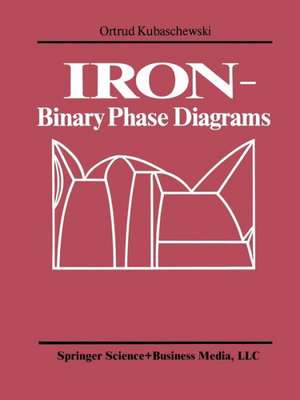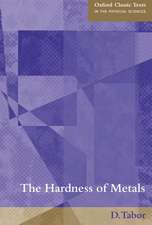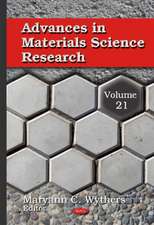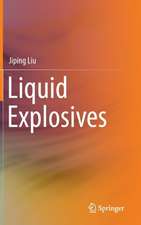IRON—Binary Phase Diagrams
Autor O. Kubaschewskien Limba Engleză Paperback – 4 ian 2013
Preț: 389.70 lei
Nou
Puncte Express: 585
Preț estimativ în valută:
74.59€ • 81.05$ • 62.70£
74.59€ • 81.05$ • 62.70£
Carte tipărită la comandă
Livrare economică 21 aprilie-05 mai
Preluare comenzi: 021 569.72.76
Specificații
ISBN-13: 9783662080269
ISBN-10: 3662080265
Pagini: 196
Ilustrații: IX, 185 p. 99 illus.
Dimensiuni: 210 x 279 x 10 mm
Greutate: 0.45 kg
Ediția:Softcover reprint of the original 1st ed. 1982
Editura: Springer Berlin, Heidelberg
Colecția Springer
Locul publicării:Berlin, Heidelberg, Germany
ISBN-10: 3662080265
Pagini: 196
Ilustrații: IX, 185 p. 99 illus.
Dimensiuni: 210 x 279 x 10 mm
Greutate: 0.45 kg
Ediția:Softcover reprint of the original 1st ed. 1982
Editura: Springer Berlin, Heidelberg
Colecția Springer
Locul publicării:Berlin, Heidelberg, Germany
Public țintă
ResearchCuprins
Fe-Ag Iron-Silver.- Fe-Li (Na, K) Iron-Alkaline Metals.- Fe-Al Iron-Aluminium (Figs. 1–3).- Fe-Am Iron-Americium.- Fe-As Iron-Arsenic (Fig. 4).- Fe-Au Iron-Gold (Fig. 5).- Fe-B Iron-Boron (Fig. 6).- Fe-Ba Iron-Barium.- Fe-Be Iron-Beryllium (Figs. 7, 8).- Fe-Bi Iron-Bismuth.- Fe-C Iron-Carbon (Figs. 9–12).- Fe-Ca Iron-Calcium.- Fe-Cd Iron-Cadmium.- Fe-Co Iron-Cobalt (Figs. 13, 14).- Fe-Cr Iron-Chromium (Figs. 15, 16).- Fe-Cu Iron-Copper (Figs. 17–20).- Fe-Eu Iron-Europium.- Fe-Ga Iron-Gallium (Figs. 21–24).- Fe-Ge Iron-Germanium (Fig. 25).- Fe-H Iron-Hydrogen (Figs. 26, 27).- Fe-D Iron-Deuterium (Fig. 28).- Fe-T Iron-Tritium (Fig.28).- Fe-Hf Iron-Hafnium (Fig. 29).- Fe-Hg Iron-Mercury (Fig. 30).- Fe-In Iron-Indium (Fig.31).- Fe-Ir Iron-Iridium (Fig. 32).- Fe-La Iron-Lanthanum (Fig. 33).- Fe-Mg Iron-Magnesium (Fig. 34).- Fe-Mn Iron-Manganese (Fig. 35).- Fe-Mo Iron-Molybdenum (Figs. 36–38).- Fe-N Iron-Nitrogen (Figs. 39, 40).- Fe-Nb Iron-Niobium (Fig. 41).- Fe-Ni Iron-Nickel (Figs. 42–44).- Fe-O Iron-Oxygen (Fig. 45).- Fe-Os Iron-Osmium (Figs. 46, 47).- Fe-P Iron-Phosphorus (Figs. 48, 49).- Fe-Pb Iron-Lead (Figs. 50, 51).- Fe-Pd Iron-Palladium (Fig. 52).- Fe-Pt Iron-Platinum (Fig. 53).- Fe-Pu Iron-Plutonium (Figs. 54, 55).- Fe-R Iron-Rare Earth Metals (Figs. 56–68).- Fe-Re Iron-Rhenium (Fig. 69).- Fe-Rh Iron-Rhodium (Fig. 70).- Fe-Ru Iron-Ruthenium (Fig. 71).- Fe-S Iron-Sulphur (Figs. 72, 73).- Fe-Sb Iron-Antimony (Figs. 74, 75).- Fe-Sc Iron-Scandium (Fig. 76).- Fe-Se Iron-Selenium (Fig. 77).- Fe-Si Iron-Silicon (Figs. 78, 79).- Fe-Sn Iron-Tin (Figs. 80, 81).- Fe-Sr Iron-Strontium.- Fe-Ta Iron-Tantalum (Figs. 82, 83).- Fe-Tc Iron-Technetium (Figs. 84, 85).- Fe-Te Iron-Tellurium (Fig. 86).- Fe-Th Iron-Thorium (Fig. 87).- Fe-Ti Iron-Titanium (Figs. 88–90).-Fe-Tl Iron-Thallium.- Fe-U Iron-Uranium (Figs.91, 92).- Fe-V Iron-Vanadium (Figs. 93–95).- Fe-W Iron-Tungsten (Figs. 96, 97).- Fe-Y Iron-Yttrium (Fig. 98).- Fe-Yb Iron-Ytterbium (Fig. 99).- Fe-Zn Iron-Zinc (Figs. 100, 101).- Fe-Zr Iron-Zirconium (Figs. 102, 103).- Appendix Table 1. Physico-chemical properties of the elements.- Table 2. Structural types of elements and compounds.- Table 3. Numerical differences between the International Practical Temperature Scale of 1968 and that of 1948.












